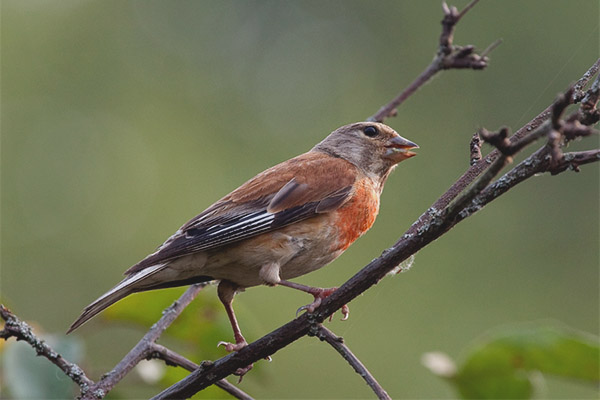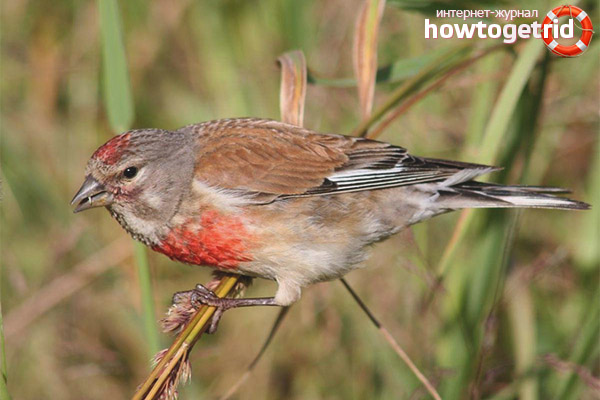The content of the article
Birds of the presented species are rightfully considered the most melodious. They belong to the passerine family, they sing melodiously, in their supply they have thousands of different sounds. Linnet is so well expressed by songs that in this respect it can circumvent a bird, nightingale or lark. You can listen to this specie in hemp fields. The main basis of the diet of birds is considered to be the seeds of this vegetation. Today we look at everything that affects the individuals of this family. We study the habitat, features and other aspects.
Description
- A linnet is a sparrow bird, which is of medium size. On the external signs of these individuals are often confused with tits. Distinctive characteristics are dimensions. On the body of the individual grow up to 15 cm. Maximum, their weight ranges from 17 to 24 grams. Among all representatives of passerine, these individuals are the smallest.
- By the color of the body, they do not stand out, pigmented by a gray-brown tone.In the area above the tail there are pinkish feathers. The lateral parts and the abdominal region are almost whitish. In the area of the neck there is a light strip. In the area of the wings there are lines of black and white podton. Black stripes are wider than white ones. The same pattern can be observed in the tail zone.
- There are differences in gender, they appear in the color of plumage. Linnet can have a scarlet spot on the head or a reddish hue of feathering on the chest. Usually these characteristics are peculiar to males. Females are not so colorful, because in the process of hatching the offspring they need to merge with the environment.
- The beak is wide at the base, but short. The color is brown with a gray tint. The length does not exceed two distances between the nostrils. This feature distinguishes the linnet from its relatives. The clawed legs are long, the toes are strong, with sharp claws. The legs are pigmented with a brown tone.
- The shape of the wings is sharp, oblong. In the peak zone there is a pair of flight feathers. The wing is approximately 8 cm long. The tail is weak and moderately long, about 4 cm.It is also worth mentioning that the palatal zone in these birds is ribbed. Thanks to what they snapping seeds and seeds with ease.
Nutrition
- In these birds, the basis of the diet is food of plant origin. Due to this food they do not need to fly anywhere in search of bugs and other insects. They are sedentary, because they can always diversify their menu with the seeds of various plants.
- However, in the summer, individuals are not opposed to eat midges, cottage cheese, ants, insect larvae and insects themselves, as well as chicken eggs. Approximately the same nutrition in babies, immature chicks due to getting protein compounds get stronger faster.
- If we consider the food of vegetable type, individuals eat sunflower seeds, burdock, plantain, sorrel, poppy and hemp (germinated grain). By their natural features, birds can eat various vegetation.
- They lean on colza and rape due to the abundance of fat in these varieties. Thanks to this diet the birds are always energetic and well fed. But they quickly digest food, so after an hour they feel hungry.
Habitat
- The represented birds can have a different habitat.Many factors depend on the specific subspecies of birds. Ordinary linnets often live on the territory of Scandinavia, the former USSR and Europe. As for the Russian territories, the individuals mostly nest in the western part.
- Crimean species of the individual does not leave the peninsula. Accordingly, such birds are not found anywhere else. As for the Turkestan repolov, they live in the territory of Iran, the Transcaspian region, Afghanistan, Turkestan, India and Mesopotamia. There is also an Asian subspecies.
- It is impossible to answer with accuracy whether the individuals in question are migratory or not. Part of the subspecies prefers to lead a sedentary lifestyle. To a greater extent this applies to those birds that mainly live in warm regions. Other liners are sent for wintering in Africa and Iran.
- Often, in conditions of ordinary existence and during flights, individuals try to keep in small flocks. In each of them there are no more than 30 individuals. Such birds move around noisily. Often, birds try to hide in the bushes and tall grass.
- The individuals in question have a huge number of enemies.Because of this feature, they are shy. Therefore, it greatly interferes with the home content of these individuals. Birds are afraid of cats, dogs and other pets. Also, birds get scared of people. Birds need shelters and cages that are high.
- Often, breeders settle hemp trees in one spacious aviary together with canaries, goldfinches and greenfinches. As a result, all represented individuals can interbreed without any problems. A quite viable young are born. As a result of such hybrids they are much easier to keep at home.
Breeding
- The nesting period in represented birds begins from mid-spring to late summer. During this time, individuals make 2 laying, each has up to 5 eggs.
- Birds hatch eggs for half a month. At this time, the male brings food. In general, after a month and a half, the chicks become independent and leave the nest.
Linnets are harmless birds. They are quite beautiful, and it is interesting to observe them in the mating season. During nesting, individuals show particular concern for each other and their offspring. Both parents are involved in feeding and raising young animals.
Video: Linnet (Carduelis cannabina)












To send